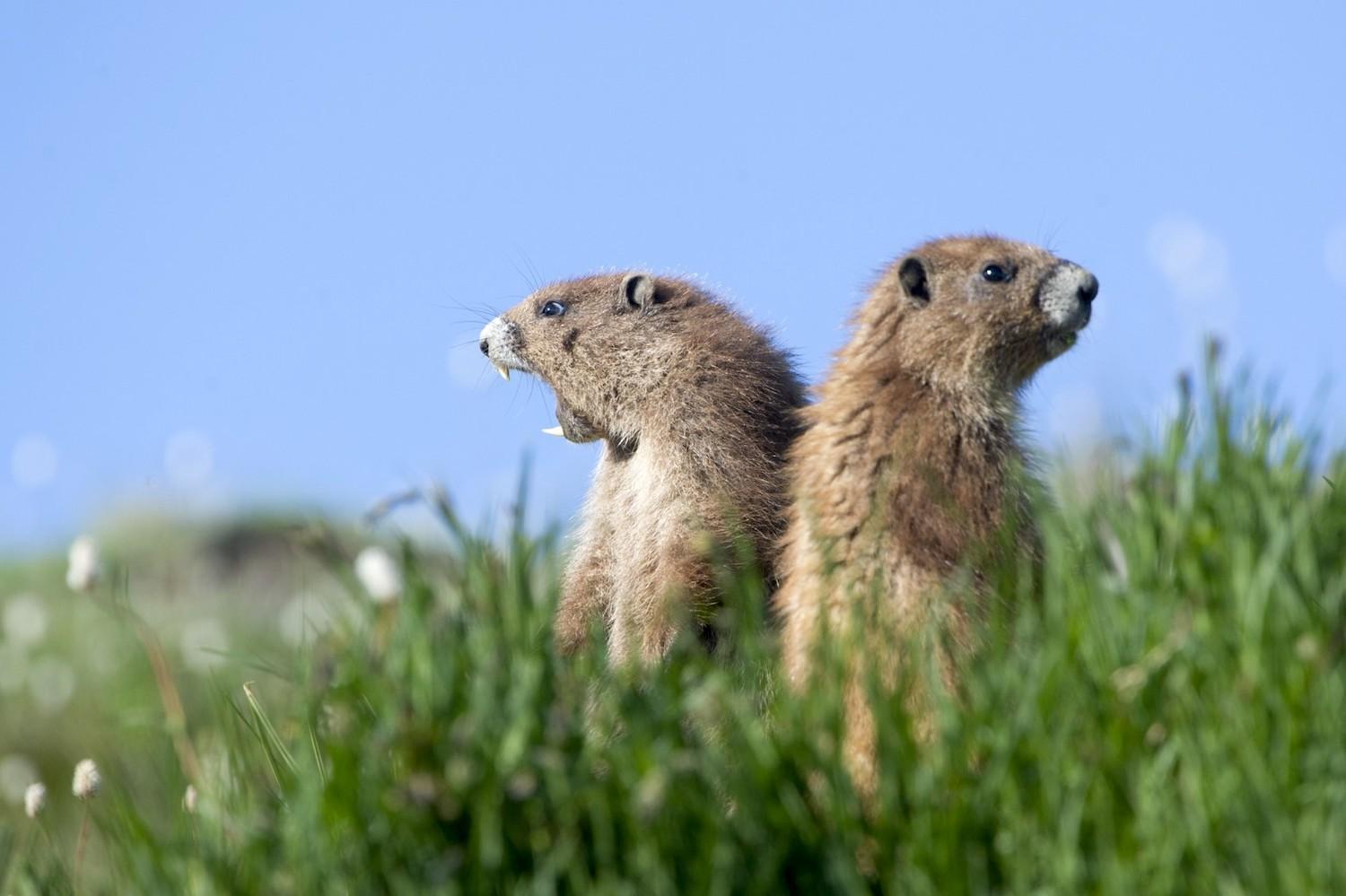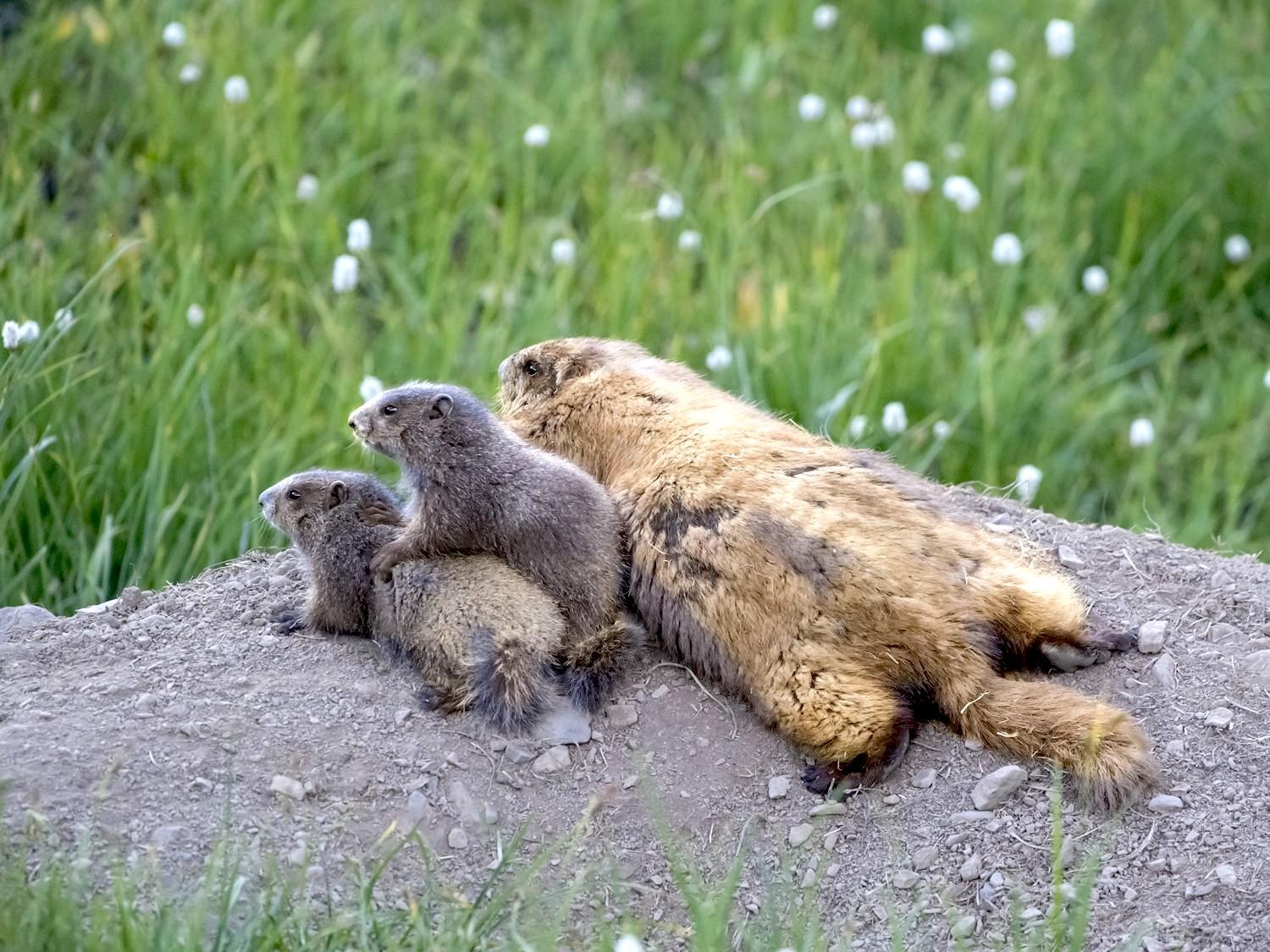
Citizen science made possible by Washington's National Park Fund is leading to better understanding of Olympic marmots/Rick Klawitter
Meet Olympic National Park’s Marmots And The Citizen Scientists Who Study Them
By Beth Glosten, WNPF Board Member
Last December, Olympic National Park wildlife biologist Patti Happe joined Washington’s National Park Fund for a Virtual Field Trip where we were introduced to one of the park’s most unique and beloved animals – the Olympic marmot. These furry creatures are genetically distinct from other marmots and endemic to the Olympic Peninsula, meaning they can only be found there. About the size of a large cat, and with coats of golden brown, chocolate, and silver-gray, Olympic marmots are social and gregarious animals.
Intrigued? Get to know the Olympic marmot with these fun facts:
- Marmots do not have sweat glands, so they have no way to disperse heat. They can be seen lying on snow, a flat rock or on bare dirt to cool down.
- Marmots live in underground burrows in the open meadows of the alpine and subalpine areas of the Olympic Peninsula, over 90 percent of which is in Olympic National Park. Their burrows are used for hibernation, protection from bad weather and predators, and to raise newborn pups.
- The open meadows where marmots burrow are often fragmented or broken up by patches of inhospitable rocky habitat, or encroaching forest. Therefore, if a meadow loses its marmot population, it can take some time for it to repopulate.
- Marmots hibernate starting in early September. Since marmots do not eat during hibernation, they store fat before becoming inactive. During hibernation, their digestive system shuts down completely. They will lose half their body mass over the winter. The body temperature of a hibernating marmot drops to less than 40 degrees Fahrenheit and their heart rate may drop to three beats per minute. Every two weeks, the animal shivers and increases its heart rate and body temperature to normal to come out of their hibernating state. It is unclear why they do this.
- Marmots emerge from hibernation in April or May. In the summer they feed on sedge shoots and the succulent parts of herbaceous plants and flowers.
- Female marmots begin to breed at three or four years of age. However, in any given year, only 15-50 percent of females will breed. Females have just one litter per year, and each litter has 3-4 pups. Pups are born in mid-June and emerge in mid-July.
Several features of our marmots contribute to their vulnerability: they are only in the Olympic Mountains, there aren’t many of them, they reproduce relatively infrequently, and it is hard for them to move to a new suitable habitat. For more than a decade, citizen scientists have played a key role in documenting data to support the park’s management planning.

Olympic marmots don't have sweat glands to help cool off, so they often will be seen lying prostrate on rocks or snow/Rick Klawitter
Marmot Research in the Park
Park scientists began researching Olympic marmot populations in the early 2000s. By examining the marmots’ burrows, a decline in the population of 7 percent per year was found from 2002-2006 for an overall decline of 40 percent. The cause of the decline was determined to be coyote predation. Most worrisome, this predation affected mostly females just before giving birth.
In 2010, with funding from WNPF, park scientists developed a system to monitor Olympic marmot populations to inform long-term population management planning. A citizen scientist program was planned to assure long-term financial sustainability; thus was born the Olympic National Park Marmot Monitoring program – a program that is fueled by volunteers.
Each year, 70 to 100 volunteers participate in this program. Between 25 and 36 groups of two to six volunteers each head out to a designated site to camp, and document evidence of marmots in patches of their habitat. Because it can be tricky to count marmots directly, the volunteers are trained to not only document marmots themselves, but to also look for boroughs and determine if the boroughs are occupied or abandoned. Evidence of recent occupancy in a borough includes kicked up dirt, fresh feces, or flattened vegetation. Habitat occupancy is tracked over time.
Over 35,000 volunteer hours have been logged contributing to our understanding of our Olympic marmot population, and nearly two-thirds of the volunteers return each year to participate in this rewarding project. Volunteer trips can range in duration and difficulty, from two-day trips exploring the front country around Hurricane Ridge to seven-or-eight-day outings deep in the park’s backcountry. While the park will provide all permits, volunteers need to bring their backcountry gear and way-finding skills.
In a typical, non-COVID year, new volunteers participate in a one-day training and orientation that involves both classroom and field work. The next day, the volunteers hike out and set up camp in the area they are to study. The study areas may be meadows or scree fields. The volunteers look for marmots, marmot burrows, and evidence of occupancy, and fill out a data form. GPS tracking confirms the area covered by the volunteer and determines the exact borough locations. Data collected over the years allows tracking of marmot populations.
Program Results
The first several years of the citizen scientist marmot monitoring program revealed that the decline in the Olympic marmot observed in the 2000s had not continued – the population was small, but it was stable and not declining further. A higher occupancy rate was found in the northeast section of the park, with fewer occupied marmot burrows found in the southwest region.
These data have also spawned further studies – one found that meadow habitats are favored over rocky, and more open spaces favored over less. The challenge of coyote predation is believed to be in part from the effects of climate change: snowpack melts out earlier in the season, allowing coyote access to the marmots not only for a longer period, but also while the females are pregnant. Future studies hope to evaluate additional effects of climate change on marmot habitat and populations.
Over 100 volunteers signed up to participate in the program this year, and we are happy to report that it is going fairly well despite the challenges associated with conducting this work while in the midst of a pandemic. This year’s first volunteers went out into the field at the end of July and the last entered the field on September 1. Volunteers were also challenged by the higher-than-normal temperatures—both in terms of them dealing with the heat personally, and in terms of the marmots not being out and about as much. Because Olympic marmots do not have sweat glands, their bodies have no way to disburse heat.
Data collected this field season has yet to be analyzed, but we are hopeful that the same sites from previous years can be surveyed and are hopeful that there will be increased marmot occupancy.
A Program that Makes a Difference
This program is a win-win: volunteers get to experience the splendors of the alpine areas of the park while making significant contributions to the park’s resource stewardship, and park staff receive needed data.
If you are interested in participating in this citizen science research project, you can learn more at Olympic National Park’s Marmot Monitoring page. And if you’d like to contribute in support of projects like this one, visit wnpf.org/all-the-ways-to-give.

Comments
We have been to Olympic Park and enjoyed it immensley! Nice photos; especially the mom and babies!
As the sub-district ranger at Hurricane Ridge in Olympic National Park from 1957 to 1959, I recall a Dave Barash reseaching Marmots there during that period. Some adults were up to 30 pounds as I recall - helping Dave weigh them. I've emailed my old boss Jack Hughes, the District Ranger then, to see if he rcalls anything about that research. Of course he's long since retired, as is the park's biologist back then: Bruce Moorhead, who I've lost track of. His wife came skiig here a few years ago, so they might still be in Port Angeles or nearby. -Eric Burr, Mazama WA